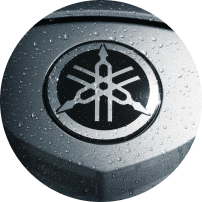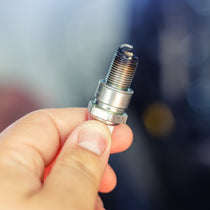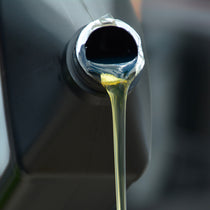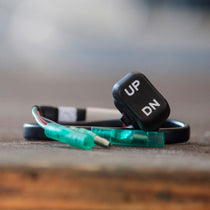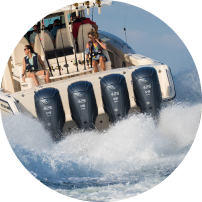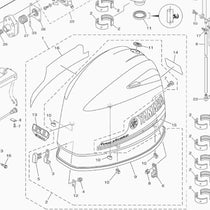

Guide to Yamaha Marine Grease
If you own a Yamaha outboard motor, you probably have wondered which type of Yamaha marine grease you need to take care of your regularly scheduled maintenance.
To address this concern and others related to Yamaha marine grease, PartsVu offers a simple guide to understand some of the most frequently asked questions about Yamaha marine grease, including:
- What kind of grease should I use on my outboard motor?
- Why marine grease?
- Is marine grease waterproof?
- Who makes Yamalube grease?
- How do you grease a Yamaha outboard motor?
- Can I use other brands of marine grease for my Yamaha outboard?
- How do I set up a grease gun?
- How do I lubricate my Yamaha outboard grease points?
What Kind of Grease Should I Use on My Outboard Motor?
To answer this question, marine grease is the right choice for all Yamaha outboard motors.
More precisely, Yamalube for Yamaha outboard motors is specifically designed to work with Yamaha’s exacting engine specifications and high performance in freshwater and saltwater applications.
Why Marine Grease?
The purpose of using grease in mechanical applications is predominantly for lubrication. However, because an outboard motor spends a significant time exposed to water and high RPMs, it needs a specially-designed grease that repels water while delivering high performance.
Marine grease serves many crucial functions for outboard motors:
- Enables lubrication between metal components to withstand extreme conditions, such as high temperatures, high pressures, shock loads, or slower speeds under heavy loads
- Lubricates hard-to-access or closed systems for extended periods without frequent replenishing
- Aids long-term storage by creating an air-tight film against moisture
- Prevents corrosion from contaminants and foreign materials
- Due to its viscosity versus oil's, grease acts to keep deteriorated seals effective and extend their lifespan without leakage
- Grease is often used in applications where installing an oil-based system is too expensive/impractical to circulate and retain
Is Yamaha Marine Grease Waterproof?
As stated before, the purpose of marine grease is to lubricate the components while also providing a reasonable amount of protection from continuous exposure to water and corrosive contaminants.
Marine grease is formulated differently than normal greases:
- First, marine grease contains additives that make it "hydrophobic," which means it is designed to repel water. A proper marine grease should have passed ASTM D1264 water washout testing - an industry standard. While standard types of grease are partially hydrophobic, it will mix much more readily with water and is not suitable for long-term applications. This can be observed in a milky white substance leftover from water-contaminated grease in it. By contrast, marine grease is much more resistant to this mixing and will not leave this residue.
- Second, marine grease is also formulated with tackifiers that enable it to be more "surface-active." Or, in less scientific terms, it makes grease stick better. All-purpose greases are usually designed to adhere to common surfaces but may actually degrade your outboard motor.
- Third, marine grease contains corrosion inhibitors for both ferrous and non-ferrous metals. This extends the life of components to protect against rust, corrosion, and pitting.
For these reasons, marine grease is not only used for parts of an outboard motor that come into contact with water but also mechanical components that transport boats (such as boat trailer bearings, steering assemblies, etc.)
Who Makes Yamalube Grease?
One of the most common questions boaters ask is, "What Is the Best Marine Grease?” For Yamaha outboard motors, the best choice is Yamalube.
Yamalube is Yamaha’s proprietary brand of marine grease. Specifically designed for Yamaha’s extensive line of outboard motors, Yamalube is a multi-purpose marine grease. It provides superior lubrication, resists washout, and adheres to all frictional surfaces unaffected by engine/boat vibrations.

Can I Use Other Brands of Marine Grease for My Yamaha Outboard?
The answer is yes; you can use other brands of marine grease to lubricate your Yamaha outboard.
However, not all brands are formulated to withstand the high-RPMs and specifications of Yamaha engines. And if you choose to use a cheaper off-brand, you may void your warranty if damage occurs.
How Do You Grease a Yamaha Outboard Motor?
Whether you choose to use Yamalube or a quality aftermarket brand of marine grease, the important thing is that you lubricate the outboard correctly.
How Do I Set Up a Grease Gun?
A grease gun is an indispensable part of maintaining your Yamaha outboard motor.
If you’ve ever used a caulking gun for household or boating applications, the process for setting up your grease gun is very similar. The only difference is that a grease gun is a closed system to prevent grease from leaking out, causing a mess.
Essentially, you load a tube into the grease gun and use a trigger-activated plunger to slowly dispense the grease through a thin hose as needed.
Installing a new tube of grease is a simple but potentially messy procedure.
- First, put on a set of gloves to avoid getting grease on your hands.
- Next, open up your grease gun. Most grease guns have a screw cap on the end of the barrel; turn counterclockwise until the unit comes apart.
- If there is any remaining grease around the screw threads, wipe it with several paper towels.
- Pull the follower rod of the grease gun all the way back until it is fully extended from the main retaining tube/cylinder.
- After opening up the cylinder, remove the plastic cap off the tube of Yamaha marine grease. Be careful not to open the pull-tab side yet.
- Insert the tube of marine grease into the grease gun cylinder, making sure the tube is secure.
- Next, remove the pull tab to expose the grease.
- Re-screw the barrel back on top of the grease gun, then back up the seal by a half-turn to help bleed air from the follower rod.
- On top of the grease gun, press the air bleed valve while slowly pushing the follower rod until you feel a bit of tension.
- Firmly screw the cap of the grease gun back on.
- Pull the trigger of the grease gun slowly to remove the air from the hose. Once you see grease appear, stop pulling the trigger.
- The grease gun is ready for use.
- To store the grease gun, replace a storage cap on the hose after cleaning residue from the barrel with a paper towel.
How Do I Lubricate My Yamaha Outboard Grease Points?
Now that you have your grease ready and primed, it’s time to grease your Yamaha outboard.
Grease points are metal fittings attached to your outboard motor that enables grease to be fed into the system under moderate to heavy pressure. What makes them easy to work with is that you don't have to remove most engine components to access the grease points.
The first step is to identify the grease points on your engine. Grease points are typically metal protrusions with a hole through the metal where grease is fed into with a grease gun. To find grease points on your outboard, refer to your service manual for your particular Yamaha model outboard and add grease where grease “A” is specified.
The process for adding grease to grease fittings is relatively simple, even for those who aren’t mechanically-inclined:
- Line up the tip of the grease gun’s hose/barrel with the grease point.
- Push the tip over the fitting as snugly as you can.
- Pull the trigger of the grease gun several times until you can feel and/or observe grease entering your outboard engine. Don’t worry about overgreasing, as excess grease tends to spill out when the grease point is full.
- Once you’re finished, thoroughly clean the grease point, but leave a thin film of grease to protect against contaminants and particles entering your engine.
- Repeat the previous steps until you’ve adequately greased your entire outboard.
That’s the entire process for greasing your Yamaha outboard engine. Bear in mind that grease points are part of every recommended service interval.
**Warning**
Do not apply grease to parts and components of your outboard motor that aren’t specifically mentioned in your Yamaha owner’s manual. Due to the viscosity of Yamaha marine grease, you can reduce the necessary friction (i.e., timing belt) of components, create a safety hazard on your boat, and many other negative outcomes.
* * *
Now that you understand the purpose of using Yamaha marine grease and how to adequately grease your outboard engine, it’s time to get your outboard lubed up! PartsVu offers a full selection of marine grease, grease kits, and more. Shop for your parts today!
This content was designed to serve as a general guide. Persons who are not familiar with marine engine repair and who have not been trained in the recommended servicing or installation procedures should have the work performed by an authorized marine mechanic. Improper installation or servicing of parts can result in engine or boat damage, personal injury to the installer, or harm to persons operating the product.

